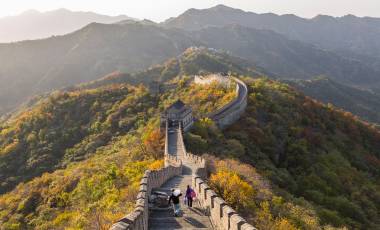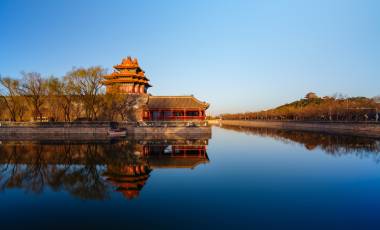Itinerary was jam-packed with great sights and activities that gave us a taste of both ancient and modern China, while still leaving some free time to explore on our own; excellent value. All the hotels were very good (luxurious for Exodus), with the Tianfu Sunshine in Chengdu being stand-out for room facilities and decor, the Bell Tower in Xi’an for location and generous room size, and the Dong Fang in Beijing for the most extensive and best quality breakfast buffet (and period charm in the historic coffee shop, courtyard, and public areas); Golden Tulip in Shanghai was also very glamorous and well-located for the Bund. Transport (bullet trains x 2, internal flight, private minibuses, and public buses) was all excellent – punctual, efficient and clean, and our trip leader, Sunny, got us to all the attractions before the busiest crowds, and marshalled us well on public transport. (There were only seven of us on my departure – five solos and one couple – which was a good number; I can imagine a full cohort of 16 would be much more challenging to manage in the busiest locations.) Food was amazingly cheap and generally good (you can eat well for a fiver, and feast for under £10; large beers cost around £1), although some of us might have liked an option once or twice to have a more upmarket and relaxed dining experience. This trip takes in all the main tourist attractions (Tian’anmen Square, Forbidden City, a section of the Great Wall, Terracotta Warriors, panda breeding centre), and they were all well worth seeing, but what I enjoyed most was having some time to explore the lesser known cities, Xi’an, and Chengdu. Xi’an was my favourite, for its historic centre, and lively night-time vibe. I would have liked some more time in Shanghai (not least because I was on a quest for family history); a day and a half on the official trip itinerary is not enough for such a vibrant city, specially as we lost half a day (the group trip to Yuyuan Garden) due to heavy rain the day we arrived. Luckily, some of us had late flights on departure day, effectively giving us another post-trip day in which we were able to visit the Yu Garden independently, but it would be good if this extra day could be factored into future trip itineraries. (Personally, I’d trade Beijing for more time in Chengdu and Shanghai. I’m planning to return to Shanghai independently.) As a solo traveller, this was my first long-haul trip, and it was brilliant. Just go!

Beijing Trips
Beijing Trips
From the Forbidden City, with ancient courtyards and temples, to Tiananmen Square, capable of holding more than a million people, our Beijing trips uncover the wonders of this fascinating city. Visit many iconic sites on our Beijing tours, including the hutongs (narrow alleys) and sections of the Great Wall.
Alongside the world-renowned landmarks, Beijing is a hotspot for Chinese culture and, although it only became the capital of China during the Ming Dynasty in the 14th century, its history spans 3,000 years.
What’s really fascinating about this megacity is how it effortlessly fuses state-of-the-art technology and ultra-modern architecture with natural sights and ancient culture as though they’ve rubbed shoulders since the beginning of time.
One of the easiest ways to get to the heart of Beijing is through its food. Chinese cuisine plays an integral role in its culture with traditional dishes passed down through the centuries. As you wander around street-food stalls, the aromas of Beijing roast duck, shredded pork, Chinese dumplings and other exotic dishes are irresistible.
Beijing Tours
Top 5 Things to Do on Beijing Trips
Visit The Forbidden City: So named because it was once forbidden to ordinary people and only the emperor could enter at free will, the Forbidden City is an imperial palace dating back to the Ming and Qing dynasties. Nowadays it’s often called the ‘Former Palace’ and is one of the most important in the world. As you explore its majestic halls, you’ll witness the magnificent artwork and traditional Chinese architecture which was designed based on the ancient art of feng shui. The site spans 178 acres and was listed as a UNESCO World Heritage Site in 1987.
Walk a Section of The Great Wall of China: One of the most epic manmade structures in the world and important pieces of Chinese history, The Great Wall of China takes you on an exhilarating journey into the past. Because the building of the wall took more than 2,000 years, there are many contrasting sections. The wall runs for more than 13,000 miles from the west to the east of Northern China and is a magnificent architectural feat that passes through some of China’s most dramatic mountain scenery. The Great Wall was originally constructed to protect North China and the Silk Road from invasion and some of the finest sections can be walked inside Beijing Great Wall National Park.
Try the Beijing Duck: Commonly known as Peking duck, Beijing duck is a traditional, and arguably the most famous, dish in Beijing. It has a long history and was once served as a royal dish in medieval times, cooked by imperial chefs for the emperor, and it even has a dedicated museum in Beijing. Traditionally cooked over an open charcoal fire, the duck would be covered in a sweet syrup and Chinese spices and served with spring onions, cucumber and hoisin sauce before wrapping in a soft pancake. It’s likely you’ve already tried Beijing duck but there’s no better place to try it than in its homeland.
Ride a Bullet Train: Home to the fastest and largest high-speed train, China created the ‘bullet train’ which can travel at a staggering 320km per hour. But what makes it even more surprising is that even when travelling at such a speed, you would hardly know you were moving if you didn’t look out of the window. The Beijing to Shanghai high-speed railway connects the Bohai Economic Rim with the Yangtze River Delta and is one of the busiest of its kind in the world.
See the Terracotta Warriors: One of the most significant and awe-inspiring architectural finds in history, the Terracotta Warriors at Xi’an are a must-see site when visiting Beijing. The life-size army of approximately 6,000 terracotta soldiers and horses were discovered in a subterranean vault in 1974 by a group of peasants. It’s believed the army was built to protect Qin Shi Huang in the afterlife and they’re made up of archers, cavalrymen, horses and generals. The level of detail of each of the models is extraordinary with no two soldiers the same, from the facial expressions and hairstyles to the armour they wear.
Ming Ho Essential China
Charlie JM Walking the Great WallThis trip was a brilliant time; every day you’re walking on the Great Wall of China, mostly in areas with few other tourists and amazing views. The weather was kind to us so the panoramas are spectacular. Our tour leader Stone was so organised and an incredible help in a country where most locals don’t speak English (my Mandarin isn’t too good either), and the food and hospitality at the local guesthouses was great too. Accommodation was better than expected having been described as basic!
AMANDA PATHE Essential ChinaI was a solo traveller and had never gone on a group trip before. The trip covered so much ground, I saw loads.
The Adventure Begins Here
Get regular inspiration straight to your inbox from Exodus’ experts.


